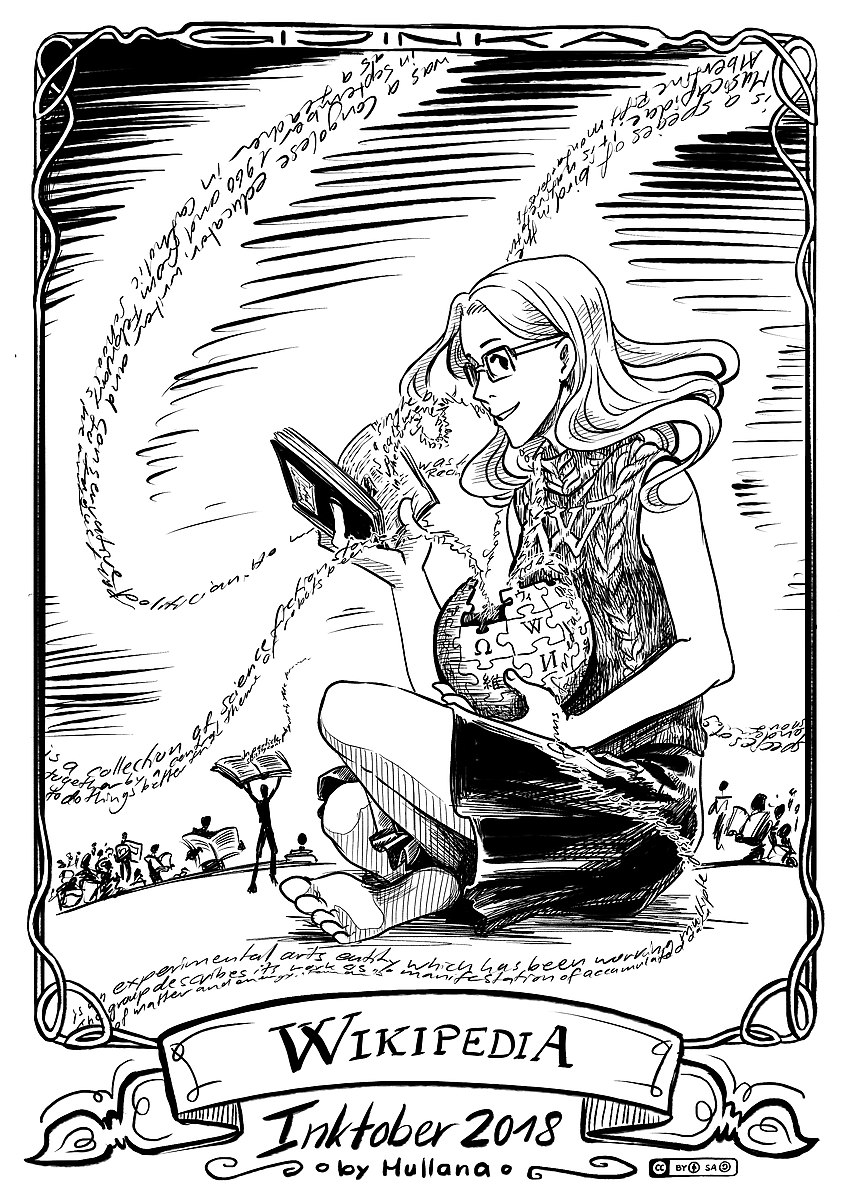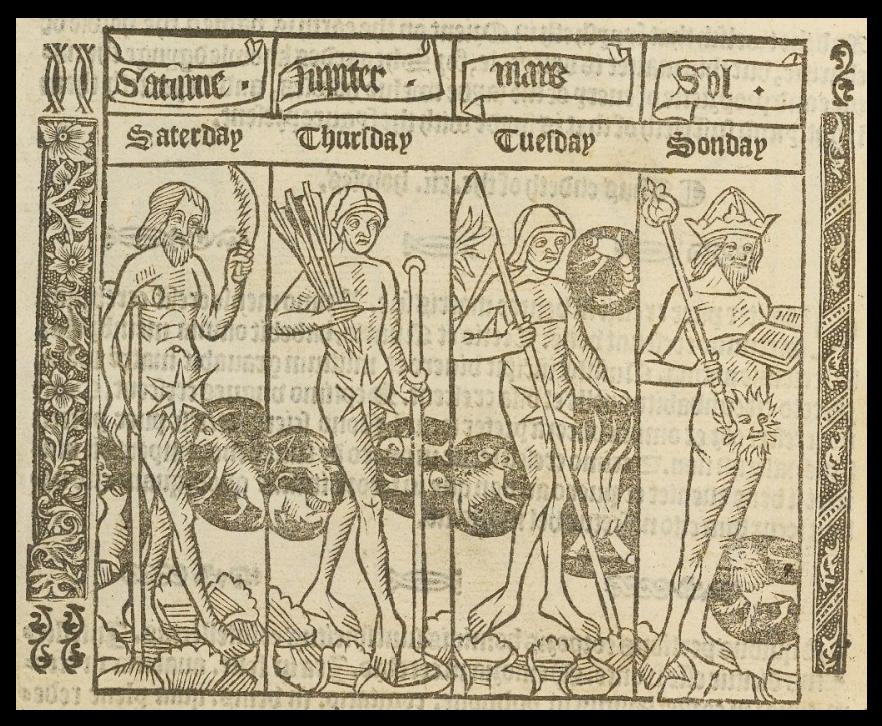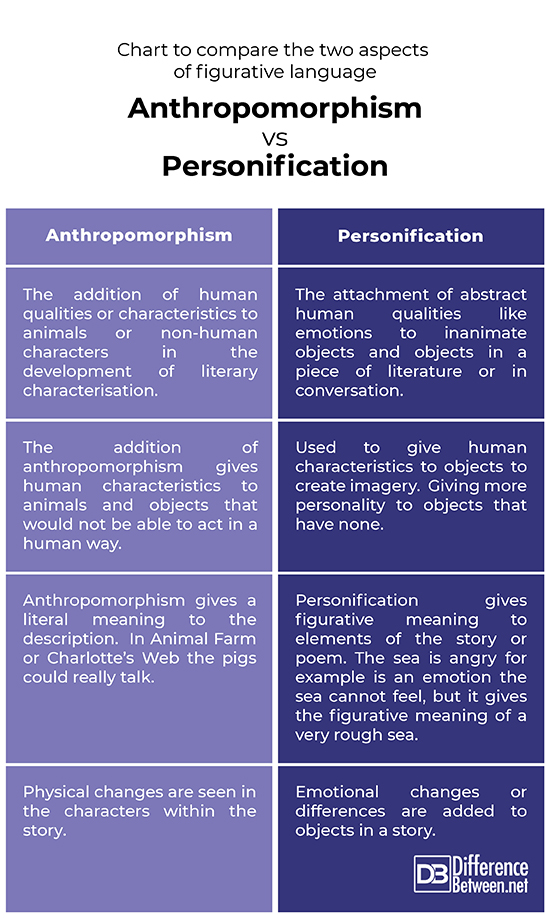Difference Between Anthropomorphism and Personification
Anthropomorphism and personification are literary devices used by writers to add personality and attributes to characters in their stories. They use these types of figurative speech to bring more humanistic character traits to the different participants in creative writing. Anthropomorphism is the transforming of animals into having more human qualities in a story. It makes animals able to talk and walk like people. The anthropomorphic character may wear clothes and even walk on two feet. Personification is used by writers to give emotional characteristics or feelings to inanimate objects that would not have feelings. For example a computer may be said to hate a person, but really a computer can not have these kind of feelings. Although both these styles of writing bring about deeper characterisation to the subject, they are different in their approach. One is directly transforming animals into characters with human characteristic while the other is used to give emotional characteristics to inanimate objects. They are both literary devices that add changes to story characters, but in a different way.

How to define Anthropomorphism
Anthropomorphism is used to give human attributes to non-human objects. They could be animals that talk and act like people or it could be inanimate objects with character and the ability to speak and have feelings. Anthropomorphism gives animals for example the ability to act, speak and think like people. This literary device is used extensively in children’s literature. Winnie the Pooh for example and his Hundred Acre Wood friends wear clothes and talk to each other too. They even talk and interact with humans, Winnie the Pooh and Christopher Robin are friends. Walt Disney is very well known for his characters who are anthropomorphic. Mickey Mouse was probably one of the earliest and best loved animal characters with human attributes. One almost begins to wonder if he is a person pretending to be a mouse or a mouse pretending to be a person!
Anthropomorphism comes from the Latin word anthromorphis meaning having human form. George Orwell’s acclaimed book, Animal Farm, used animal characters to fight for their rights among the unfair rule of the humans and some of the other animals. One of the interesting aspects of this story is that as the animal characters grew stronger in the book so their human characteristics grew stronger too.
The opposite of anthropomorphism is dehumanisation. A cruel and heartless way to belittle human beings and make them be seen as less than human in some way. Instead of uplifting the character the person is made to feel less worthy by being dehumanised. Their human characteristics are eroded and they become less thought of or even disposable because they are no longer looked on as worthy of human respect. By giving them an animal’s image especially a beast of burden or an animal seen to be dirty, like a pig, anegative emotion felt instead and people are made to feel less worthy.
How is anthropomorphism used in literary circles?
Anthropomorphism helps the author to create attributes to the characters in the story that readers can relate to. This is especially true for young readers who love animal characters. When the author adds some human characteristics to the story it is made easier for young readers to understand the feelings of the animals. George Orwell did not pitch his story Animal Farm at young readers. He used his anthropomorphic characters to show adult readers an ugly side to human nature and contrast different aspects of animal behavior with the concepts of politics and revolution. These aspects of society were seen through the acts of the animals as they took over the farm.
Anthropomorphism can be comical too. Characters like the Pink Panther are seen on the screen in their human and animal form while causing disturbances wherever they go. The movie world makes good use of anthropomorphic characters and these characters in turn become popular animated cartoon personalities.

How to define personification
Personification is a figure of speech and used to add character to objects in stories and creative writing. Personification allows inanimate objects to have feelings and personalities. This figure of speech sets up emotions and feelings and even attitudes that would not be attributed to something that has no life as we understand it inhuman terms. Personification gives emotional behavior to inanimate objects. Many of these personifications come out in smilies and comparisons. Love is blind for example. This is a personification because it is not possible for love to be blind. Love is an abstract concept and has no vision.
The weather appears to be an area where the use of personification helps people to understand the nature of some weather conditions. People try to explain typical weather attributes by adding personality to the types of weather we experience. The sun is smiling at me, or an angry storm is raging, suggest emotion and personality for weather. The writer of poetry or prose uses personification to advantage in creating imagery and emotions for objects that would not normally have such characteristics. Personification helps the writer to connect on a more personal level with the reader.
How is personification used in literary circles?
Personification helps the writer to connect on a more personal level with the reader. It is an emotional hook in a story or poem and can evoke positive or negative responses.
The sea with all its different ebbs and tides is often personified in poetry and prose. The sea can be described as angry, calm, unforgiving and even cruel. Personification gives emotional attribute to characters or objects in a story without changing their natural proportions. This figure of speech centres on the feelings that the reader can identify with so that they can make an emotional connection with an abstract element of the story.
What are the benefits of using Anthropomorphism and Personification in poetry and prose?
The most important benefit is the opportunity for the writer to connect with the reader and add deeper meaning to characters and events in a story. The use of anthropomorphism literally gives animal characters human life through the attachment of human shape and movement. The use of personification draws the reader closer to the emotional side of the characters that maybe abstract or lacking in emotional qualities. They simply give ’life’ to the emotions and character traits the writer wants to highlight.
William Wordsworth wrote ‘I wandered lonely as a cloud’ to emphasise how lost he felt. One can picture the loneliness and wandering through the imagery of the cloud.
In Shakespeare’s Romeo and Juliet the grey’ed morn is described as smiling on the frowning night. Two opposite times of the day having the ability to smile and to frown. This very figurative language draws the reader into feeling better that day has dawned and a deeper sense of sorrow that the night was so sad.
In everyday life how often do we hear expressions like ‘opportunity knocks’ or ‘that name rings a bell’ describing actions with anthropomorphic characteristics. The use of figurative language definitely makes many expressions more interesting and colorful.
Chart to compare the two aspects of figurative language:

Anthropomorphism and personification add value in their specific ways to creative writing. The writer uses these forms of descriptive writing to enhance characters and define different emotions. These emotions bring more life to a character or an object that has no life. The object with perceived personality is more relateable. Poetry in particular is full of personification and this form of figurative description really helps to bring poetry to life. Anthropomorphism is a great way to draw children into stories and help with their understanding of characters as they relate to the bear that talks or the rabbit that sings. Movie making and animation have used anthropomorphic characters to good advantage. Young children do enjoy seeing their favorite toy characters come alive in an animated cartoon show.
Undoubtedly these two styles of character building have added value to many stories and literary articles. The use of personification in particular enables the reader to have a deeper understanding of the character that is being written about. Fantasy and fairy tales would be very dull without anthropomorphism and personification. Imagine Beauty and the beast without the anthropomorphic beast and the personified candlestick, teapot and clock.
- Difference Between Lagoon and Bay - October 20, 2021
- Difference Between Futurism and Preterism - August 12, 2021
- Difference Between Dichotomy and Paradox - August 7, 2021
Search DifferenceBetween.net :
Leave a Response
References :
[0]Spacey John. 7 examples of Personification. Www.simplicable.com/new/personification Nov 2018 pub simplicable.
[1]Spacey John. 7 examples of Personification. Www.simplicable.com/new/personification Nov 2018 pub simplicable.
[2]Nordquist Richard. Personification a figure of speech. Www.thought.com/May 20 2020pub. Dot Dash publishers
[3]Admin-pedia.com/difference between Personification and anthropomorphisim/admin/mukunthan. Pub pedia.com Feb 18th 2016 Pedi.com
[4]Image credit https://commons.wikimedia.org/wiki/File:The_personification_of_the_7_planets.JPG
[5]Image credit: https://commons.wikimedia.org/wiki/File:Gijinka_of_Wikipedia_for_Inktober_2018_Anthropomorphism.jpg
